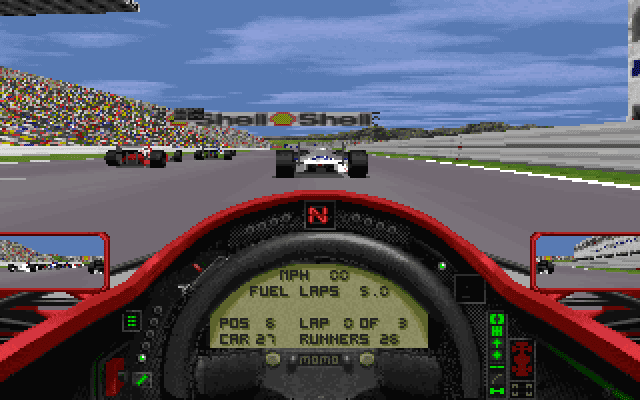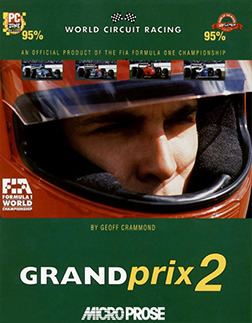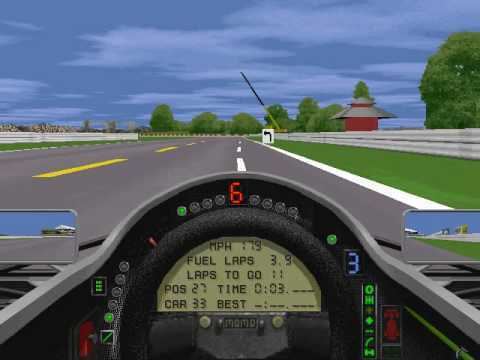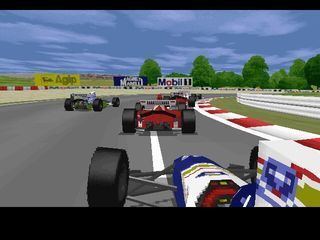9 /10 1 Votes
Genre(s) Simulation racing game | 4.5/5 GamesNostalgia Initial release date 1995 | |||||||||||||||||||||||||||||||||
 | ||||||||||||||||||||||||||||||||||
Mode(s) Single-playerMultiplayer Similar Grand Prix games, MicroProse games, Sim racing games | ||||||||||||||||||||||||||||||||||
Formula 1 grand prix 2 gameplay pc game 1995
Grand Prix 2, sometimes known as "GP2" and sold in the American market as Grand Prix II, is a racing simulator released by MicroProse in 1996. It was made under an official FIA license that featured the Formula One 1994 season, with all of the circuits, teams, drivers and cars. The cars were painted with liveries reflecting the races that did not allow tobacco and beer sponsors (e.g. 1994 British Grand Prix).
Contents
- Formula 1 grand prix 2 gameplay pc game 1995
- Racing game classics grand prix 2 pc gameplay pure sound
- Gameplay
- Development
- Features
- Critical reception
- Cracking the Code Modding community
- The Zenith of the GP2 community
- Decay and Today
- References

It had 3D texture mapping and SVGA graphics, as well as an early but realistic physics engine. A large community of GP2 enthusiasts formed quickly and still exists today. Grand Prix 2 is recognized as one of the definitive racing simulations of its era.

Racing game classics grand prix 2 pc gameplay pure sound
Gameplay

The game is a simulation of the 1994 Formula One season with all 16 circuits from the 1994 season and 28 drivers in their 14 teams. Unlike the real 1994 season, where teams changed drivers and sponsorship liveries repeatedly, the game has a consistent driver list and set of liveries throughout, which reflects that of the 1994 British Grand Prix. As a result, Ayrton Senna and Roland Ratzenberger, who both were killed during the 1994 San Marino Grand Prix are not present in the game. The liveries for each of the cars are also based on their appearance at the 1994 British Grand Prix, where all teams ran non-tobacco livery. It includes all parts of a Formula One weekend, including practice, qualifying and racing. It also included a championship mode which simulated the entire season.

There was no "arcade" mode in Grand Prix II, per se, but it included the ability to turn on and off such things as indestructibility. There were seven major functions called "driving aids" that could be turned on or off: steering help, braking help, automatic turn-around (has the car face forward after a crash), indestructibility, racing line help, automatic shifting and traction control. The game had five levels of difficulty one could choose from, and the higher the level, the less options for driving aids one could turn on or off.
There also is a "Quickrace" function that lets the player jump into a race without having to go through the perfunctory qualifying session. The quickrace option was customizable, allowing a player to race as many laps as desired and allow the player to set their grid position.
The player selects the car they will drive among the 28 seats available, supplanting the driver who originally raced in that vehicle.
The game had multiple camera angles, including a simulated TV coverage angle. A player can control his or her car from any of them, but the primary angle used was the first-person cockpit angle.
The cars can be customizable in myriad ways through the setup function. Car setups could be modified to high detail with a high degree of accuracy and attention to detail.
Usually people raced as single player. The game also offered multiplayer and modem-linked gaming.
A race can be played in turns, with different players driving different cars in the race. Gameplay in this mode has one player at a time driving their car in the race. Instead of a split screen game, The computer simulates the driving for the other players' cars when they are not being controlled by one of the players waiting their turn.
The game also featured a replay function and save game feature. The replay function showed the last ~30 seconds of racing and included the ability to save replays. It did not include an edit function.
The save game feature allowed players to save their progress in the game
The game also replicated engine, gearbox and electronic failures. This meant cars not only could crash, but also have flames or smoke shoot out of the backs of their cars from engine failure, to which they raced around the circuit damaged for a limited time before parking at the side of the road or in the pits. This was the first to simulate visual car failures; as in 1989's Indianapolis 500: The Simulation cars fell out of the race but went to the pits and parked permanently when a car failure was present.
Grand Prix II did not include wet weather conditions. There also was the lack of a 'black flag' system replicating Formula One regulation penalties for course cutting, instead slowing the car down for a limited period of time if the course is cut through.
Development
The game was developed by Geoff Crammond as a follow up to 1991's Formula One Grand Prix (which was known as World Circuit in the US).
It was the first serious racing simulation programmed with all three axes in it—i.e. the ability for vehicles to get airborne in the game. (1990's Stunts and Stunt Driver featured this ability, but were not racing simulations of a series.) However, GP2 lacked the feature of having a car flip over entirely, which not yet was seen in hardcore racing simulations. In some cases, the game would crash if the car was about to overturn. Microsoft's Monster Truck Madness (1996), simulating monster truck racing, may have been the first to have that feature.
It included more extensive physics and included image mapping over the 3D model of the car to show vehicle liveries, a feature that emerged in racing simulations with Papyrus' 1993 IndyCar Racing.
Features
There are many features that caused the game to be hailed positively:
Critical reception
Critics hailed Grand Prix II as stunning and the class of the field for Formula 1 simulations. At that time,
Cracking the Code / Modding community
Because of its revolutionary true-to-reality style, programmers began to crack the code. The first known Track Editor was built by Andy Barganski, and a collection of new circuits built using this editor were published (commercially) by Instant Access Int Ltd. René Smit and Frank Ahnert created Gp2lap, that read the track files from the hard-disk instead of the CD, so track editing would be possible. Paul Hoad programmed the Gp2 TrackEditor, the CarEditor and the JAM Editor (texture importer/exporter) with the help of many beta testers, too numerous to be named here. As soon as tracks and cars became editable, the GP2 modding community began to grow. New track commands allowed better-looking, more challenging circuits and with less bugs. Many racing leagues were created with customized cars and helmets (the car liveries pack is called a "carset") and modified engine power.
Another breakthrough came with possibly the most used editor in the history of the game. Steven Young's GP2edit added an unrivaled easy-access carset maker. The simple UI and the range of the program meant that anyone could use it without prior knowledge or having to use multiple programs. As more versions were released, the programs power increased. Menu helmets, ingame helmets, sounds, pit-crew colours, track textures & adverts, team & driver performance, camera angles, tyres and even the number position on the car could be edited.
Steven went on to create GP3edit for GP2's successor Grand Prix 3.
The Zenith of the GP2 community
While Juha Viitala, Daniel Ketteringham, Pieter van Dieren and PK Arnall created each year the latest Formula 1 carset, they also made old seasons, from the golden era (50s and 60s) to the wing era (70s), the turbo ages (80s) and the technological era (90s). CART, F3000 and other series were also featured, but were less popular than F1 and fictional carsets. Adalberto Zapparoli, Andreas Bosch, Dereck Hicks, David Richards, Warren Jenks, Gabriele Moschetto focused on tracks, specially those of the F1 season, but also other FIA circuits in Europe and America, and also form Australia and other countries visited by CART, MotoGP and popular motorsport categories (Rio de Janeiro, Kyalami, Motegi...) On the other hand, people like Adie Walti, Martijn Keizer, Graeme Nash, John Edwards, Matti Laitinen, Jason Sinnbeck, Thomas Stephanskirchner and Phil Paterson focused on creating fictional tracks. Flexibility in track design produced interesting results: driving challenges, overtaking paradises or irrational madness.
In addition, Internet-based competitions such as LFRS, and Jon Edgar's GP2 Championship evolved, whereby competitors drove their individual races within GP2 then submitting them to a website which compiled overall results from their race times, providing a form of human competition to the game.
Decay and Today
After the release of Grand Prix 3 most patchers moved on from GP2. Late 2000 the Grand Prix 2000 patch was on sale; again the GP2 modding activity decreased. Grand Prix 4 (2002) almost killed the GP2 community altogether, as 2002 and 2003 updating rates show. But still some people carried on making carsets and tracks. The EVDJSR team and the NPSW team made carsets until 2005; Andreas Schulz, Antonio Pessoa, Otavio Silveira, Roberto Remédio, Alex Cherkashin and Carlos Pereira built tracks. These experienced patchers helped breed a new wave of track designers like CAP, Dereck Hicks and David Richards.
In early 2006 TeamGp2 was formed by Nick Pathuis, EVDJS and Fridjof Knirsch (a.k.a. "FK"). But after some months the team disappeared. Henning Fisser (HF) founded HFGP2 (now HF cars and sets) and went on making GP2 carsets. Tim De Klein recurred to the szene and made carsets for the 2001 to 2006 seasons and MWi made Champ Car sets to prove the community was still around and alive and had diversity.
Toward the end of 2006, two relative newcomers to the mod scene Alexander Diehl (AD) and Moonraker created the MARD Team (MARD). Although they have been playing GP2 since its release, they only recently decided to contribute to the ailing "GP2 MOD scene" and help keep the scene alive. Their creation is the Grand Prix Racing League (GPRL), a fictional series with fictional drivers and some fictional tracks (the others being real). For this fictional series they popped up a forum which contains all necessary news about the fictional series like team launches, reports about the pre-season testings and the race-weekends: Grand Prix Racing League Community. But since the end of 2007 it got quiet about the project.
2007 sees the community still have a team of dedicated core fans. A new GP2 forum popped up (http://hfgp2.hf.funpic.de/forum/). Tim de Klein (a.k.a. "Tdk"), David Stunnenberg (a.k.a. "DJS") and Henning Fisser (a.k.a. "HF cars and sets project" or "HF") continued making carsets and several new people made several cars. With a growing number of people editing and modding the game the game is enjoying a revival.
Toward 2008 two of the best active patcher decided to come in "NL²" together: Tim de Klein (a.k.a. "Tdk") and David Stunnenberg (a.k.a. "DJS"). The name is a tribute to their citizenship. They started with a 2007 / 2008 testcarset and seem to have big success with it. People like Fridjof Knirsch (a.k.a. "FK"), Henning Fisser (a.k.a. "HF cars and sets project" or "HF") Merten Wischnewsky (a.k.a. "MWi") or Alexander Diehl (a.k.a. "AD") stay active but created alternative carsets and/or cars. Thomas Kost, rremedio and Antonio Pessoa created new tracks at this time.
2009 Two championships continues active in the Internet. Disputed by hotlaps, Fórmula GP2 and GP2CUP(Both organized by Leonardo Barbosa). Beside this competitions there also started 2 management simulations in the grandprix2.de-forum. The registered members could choose or create a team (depending on the championship), got a budget and were able to take care of the team as manager. The first championship started in real F1 in 1991 but was abandoned in the early 1993er season. The second one was only run with fictional teams and due the great success the series moved to an own homepage.
From time to time the Patchers and Fans periodically release fansets on grandprix2.de, so you can see better who was active at this moment.
